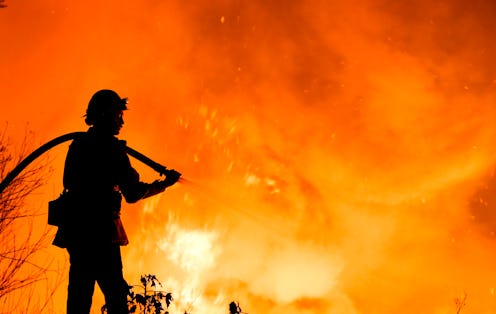News
How Women Firefighters Protect Each Other On & Off The Front Lines

Whether it's a lack of maternity care resources, systemic discrimination, or outright sexual harassment, for women who are firefighters, the industry can be a hostile environment — all in addition to the danger they face when in the line of duty. However, according to a recent study, while women firefighters face greater risks on and off the front lines, they're also the key to changing the culture for the better.
"Getting women together to talk about their experience being women in this traditionally male-dominated industry is very emotional," Jennifer Taylor, director of the Center for Firefighter Injury Research and Safety Trends, tells Bustle. "People aren't asking them about this. People aren't giving them a place to talk about this."
Taylor co-authored a FEMA-funded research study published in the Journal of Workplace Behavioral Health that centered on women firefighter's techniques and how they make the industry safer overall.
"It's always been interesting to me, when we think about risky work and how women in general look at risk," Taylor says, "how we’re socialized to look at risk, and how when we’re doing physical work, we tend to take a timeout and maybe discuss as a group opportunities for safety or concerns we have with the task."
"On my crew, I am the only woman."
Based on her previous research of women firefighters, Taylor saw that women can potentially "bring safety as a part of their skill-set to the fire service." And since safety is something the industry has been prioritizing, Taylor says, she asked herself, "What if we put more women in the fire service? Because we are socialized to look at risk differently, might it not help if we have more women in leadership?"
While a lot of her data shows that women assess risk differently than men, it's a difficult phenomenon to study in the field, as there aren't many crews comprised of just one gender. "It’s just not the way things are set up," Taylor says. And women are often the minority on a team.
"On my crew, I am the only woman," says Bailey McDade, a 25-year-old wildland firefighter. "I rely on everyone on my crew equally for safety," McDade says, "but for a little 'girl talk' in our downtime after being surrounded by guys all the time, it’s definitely nice to hang out with the girls from other crews. I live with a girl from another fire crew now, and it’s really great to have someone around that just really understands the job and the lifestyle."
McDade and her female counterparts make up 12 percent of the government’s permanent wildfire suppression jobs at the Forest Service, Bureau of Land Management, and National Park Service. That number remains low, not because women can't handle the physical demands of the job, but rather the industry hasn't always been welcoming to women. According to a 2008 National Report Card on Women in Firefighting, 85 percent of women reported they were treated differently from men, the Washington Post reported. Many claimed they were harassed, propositioned for sex, and had to deal with hostile language 15 times more often than men.
"It’s not that women do this better than men, but they bring a perspective that's missing."
Multiple former female wildland firefighters told the Washington Post that they'd experienced instances of harassment and assault, including supervisors monitoring their periods, being touched inappropriately, stalked, or spied on while bathing. One woman claimed she was fired after reporting her harassment. In April 2016, Fairfax County firefighter Nicole Mittendorff committed suicide, and officials later discovered sexually suggestive messages about Mittendorff on a website that had been posted by her colleagues.
It's this kind of toxic culture that has kept a lot of women out of the firefighting industry. "That’s really bad for the fire service," Taylor says. "If that’s what people think about the industry, you're not going to have women, you're not going to have people of color, or men of different orientations signing up."
But for a lot of young women, the culture of firefighting is shifting. "I have honestly never felt more comfortable at a job than I do now in fire," McDade says. "There is zero tolerance for harassment from or toward both men and women, and we have avenues to go through to make sure people are comfortable reporting any incidents of not just sexual harassment, but also discrimination, bullying, the whole nine yards. We really try to develop good crew dynamics so that issues can be dealt with right away at the source, before they become larger problems."
Taylor's study showed that not only do women's ergonomic techniques help them perform physical tasks — "they're thinking about what might be done differently, because biomechanically and structurally they’re different from men" — they're also more willing to ask for help and to hold colleagues accountable for misconduct.
"The place where policy falls apart is in implementation," Taylor says. "And so if the person who’s in charge of a particular fire station is looking the other way when he or she hears or sees somebody doing something inappropriate, then that's going to be the prevailing culture in that station."
More women leaders in the firefighting industry, Taylor says, "may encourage men to adopt this same approach to risk." She stresses that "it’s not that women do this better than men, but they bring a perspective that's missing from the fire service." She considers now to be a pivotal time for change.
"There's an opportunity for both genders to really embrace safety and do the work that they love without getting hurt," she says. "It's something the industry wants, but they haven't been looking at gender as a part of that solution."